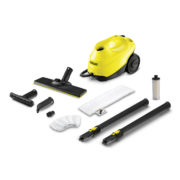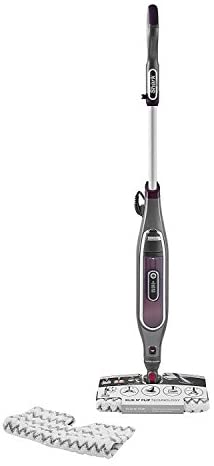In this article, you will learn some helpful tips to improve the performance of your steam cleaner. Keeping your steam cleaner in top condition is crucial to ensuring that it runs efficiently and effectively. With these tips, you’ll be able to get the most out of your steam cleaner, achieving the best results possible.
Firstly, it’s important to regularly clean and maintain your steam cleaner. This means emptying and cleaning the water tank after each use, as well as regularly checking and cleaning the nozzles, brushes, and other attachments. By keeping your steam cleaner clean and well-maintained, you’ll prevent any buildup or clogs that could affect its performance.
Secondly, make sure to use the right cleaning solution for your steam cleaner. Different steam cleaners are designed to work with specific solutions, so it’s important to read the manufacturer’s instructions and use the recommended solution. Using the wrong solution can not only reduce the cleaning power of your steam cleaner, but it can also cause damage to the machine. By using the correct cleaning solution, you’ll optimize the performance of your steam cleaner and achieve the best cleaning results.
Understanding Steam Cleaners
Steam cleaners are powerful tools that can effectively clean and sanitize various surfaces in your home. These appliances use the power of steam to remove dirt, grime, and bacteria without the need for harsh chemicals. They are especially useful for individuals with allergies or sensitivities to traditional cleaning products. In this article, we will discuss how steam cleaners work, the different types available, and the benefits of using them.
How do steam cleaners work?
Steam cleaners work by heating water to produce steam, which is then used to clean and sanitize surfaces. The steam is typically heated to a temperature of around 200 degrees Fahrenheit, which is hot enough to kill most bacteria and germs. As the steam is applied to the surface being cleaned, it loosens dirt and grime, making it easier to wipe away.
Different types of steam cleaners
There are several types of steam cleaners available on the market, each with its own unique features and advantages. The most common types include handheld steam cleaners, steam mops, and cylinder steam cleaners.
Handheld steam cleaners are small, portable devices that are perfect for spot cleaning and reaching tight spaces. They are lightweight and easy to use, making them ideal for quick and convenient cleaning tasks.
Steam mops, on the other hand, are designed to clean and sanitize floors. These devices resemble traditional mops but use steam instead of water and detergent. They are equipped with a reservoir for water and typically have a removable microfiber pad for easy cleaning.
Cylinder steam cleaners are larger and more powerful than handheld steam cleaners and steam mops. They are equipped with a separate water tank and a long hose, which allows for extended cleaning sessions without the need to refill the tank. Cylinder steam cleaners are versatile and can be used to clean a variety of surfaces, including floors, countertops, and upholstery.
Benefits of using a steam cleaner
Using a steam cleaner offers numerous benefits that make it an excellent choice for your cleaning needs. Firstly, steam cleaners are environmentally friendly because they do not require the use of chemicals. This not only reduces your carbon footprint but also ensures that your home remains free from harmful residues. Additionally, steam cleaners are highly effective at removing dirt, grime, and bacteria, giving you a cleaner and healthier living environment. Steam cleaning is also a time-saver as it eliminates the need for scrubbing and soaking, making your cleaning tasks quicker and more efficient.
Preparing Your Steam Cleaner
Before using your steam cleaner, it is important to take a few preparatory steps to ensure optimal performance and safety.
Checking the water tank
The water tank is a crucial component of your steam cleaner, as it is responsible for producing the steam necessary for cleaning. Before using your steam cleaner, always ensure that the water tank is filled to the recommended level. This will ensure continuous steam production during your cleaning session, preventing interruptions.
Ensuring proper power supply
Steam cleaners require a stable and reliable power supply to function effectively. Before use, check that the power cord is in good condition and make sure that the electrical outlet is working properly. Avoid using extension cords or power outlets that are already overloaded, as this can affect the performance of your steam cleaner.
Cleaning the attachments
Most steam cleaners come with a variety of attachments that are designed to tackle different cleaning tasks. These attachments should be kept clean and free from debris to ensure that they function properly. Before each use, inspect the attachments for any signs of damage or wear and clean them thoroughly if needed.
Choosing the Right Cleaning Solution
While steam cleaners primarily rely on the power of steam, using a cleaning solution can enhance their effectiveness, especially when dealing with tough stains and odors. However, it is essential to choose the right cleaning solution to avoid damaging your steam cleaner or the surfaces you are cleaning.
Importance of using the right solution
Using the wrong cleaning solution can have adverse effects on your steam cleaner and the items you are cleaning. Some cleaning solutions can leave behind a residue that can clog the steam cleaner’s internal components or damage delicate surfaces. Therefore, it is crucial to choose a cleaning solution that is specifically designed for use with steam cleaners or one that is recommended by the manufacturer.
Types of cleaning solutions available
There are several types of cleaning solutions available for use with steam cleaners. Some common options include all-purpose cleaners, carpet cleaners, and upholstery cleaners. When selecting a cleaning solution, consider the surface you are cleaning and the specific issue you are trying to address. For example, if you have carpeted floors, choose a carpet cleaner that is compatible with your steam cleaner.
Safety precautions when selecting a cleaning solution
When using a cleaning solution with your steam cleaner, it is important to read and follow the manufacturer’s instructions carefully. Some cleaning solutions may require dilution, while others are ready to use. Be sure to wear appropriate protective gear, such as gloves, when handling cleaning solutions and avoid contact with your skin or eyes. Additionally, always test the cleaning solution on a small, inconspicuous area before proceeding with the full cleaning to ensure that it does not cause any damage or discoloration.
Proper Operation of the Steam Cleaner
To achieve the best results with your steam cleaner, it is important to understand the proper operation and settings.
Setting the right temperature
Most steam cleaners allow you to adjust the temperature based on the surface and level of cleaning required. It is important to select the right temperature setting to avoid damaging sensitive surfaces. For example, lower temperatures are suitable for delicate surfaces like upholstery and curtains, while higher temperatures are more effective for deep cleaning tasks.
Using the correct steam pressure
In addition to temperature control, many steam cleaners also allow you to adjust the steam pressure. Higher steam pressure is ideal for stubborn stains and heavily soiled areas, while lower steam pressure is suitable for more delicate surfaces. Always start with the lowest steam pressure setting and gradually increase as needed.
Proper technique for steam cleaning
To optimize your steam cleaner’s performance, it is essential to use the proper technique when steam cleaning. Start by pre-treating any stained or heavily soiled areas with the appropriate cleaning solution. Next, slowly pass the steam cleaner over the surface using long, overlapping strokes. Avoid saturating the surface with too much steam, as this can lead to excessive moisture and longer drying times. Finally, use a clean microfiber cloth or mop to wipe away any loosened dirt and grime.
This image is property of images.unsplash.com.
Targeting Specific Areas
Steam cleaners are versatile tools that can be used to clean a variety of surfaces in your home. Here are some tips for effectively cleaning specific areas with your steam cleaner.
Cleaning floors and carpets
When using a steam cleaner to clean floors, start by removing any loose debris or dust. Then, using the appropriate attachment or microfiber pad, pass the steam cleaner over the surface in slow, methodical motions. Be sure to follow any specific instructions provided by the manufacturer for your particular type of flooring. For carpets, it may be beneficial to use the steam cleaner in conjunction with a carpet cleaner to fully remove stains and odors.
Sanitizing kitchen surfaces
The kitchen is often a hub of activity and can quickly become a breeding ground for bacteria and germs. To effectively sanitize kitchen surfaces with your steam cleaner, focus on areas such as countertops, stovetops, and sinks. Use the appropriate attachment or brush to target stubborn stains and grime. Be sure to hold the steam cleaner over each area for a sufficient amount of time to ensure proper sanitization.
Refreshing upholstery and curtains
Steam cleaners are also excellent for refreshing upholstery and curtains, eliminating odors and removing stains. Before starting, check the manufacturer’s guidelines to ensure that steam cleaning is suitable for the specific fabric. Always test a small, inconspicuous area first to ensure that the steam cleaner does not cause any damage or discoloration. Slowly pass the steam cleaner over the fabric, using sweeping motions to cover the entire surface.
Maintaining Your Steam Cleaner
Proper maintenance of your steam cleaner is essential to ensure its long-term performance and reliability.
Cleaning the steam cleaner after use
After each use, it is important to clean your steam cleaner to remove any remaining dirt, debris, or cleaning solution. Empty and rinse the water tank thoroughly, and wipe down the exterior of the appliance using a damp cloth. Remove and clean any attachments or brushes according to the manufacturer’s instructions.
Descale and remove mineral deposits
Over time, mineral deposits from hard water can build up in your steam cleaner, affecting its performance. Regular descaling is necessary to remove these deposits and keep your steam cleaner in optimal condition. Follow the manufacturer’s instructions or use a descaling solution specifically designed for steam cleaners.
Replacing worn-out parts
Like any appliance, steam cleaners may require the replacement of worn-out or damaged parts over time. Check the manufacturer’s guidelines for recommended replacement intervals and inspect the seals, gaskets, and brushes regularly. If any parts show signs of wear or damage, replace them promptly to ensure your steam cleaner functions properly.
Troubleshooting Common Issues
Even with proper maintenance, you may encounter some common issues with your steam cleaner. Here are some troubleshooting tips to help you address these problems.
Steam not generating
If your steam cleaner is not producing steam, first check that the water tank is properly filled and the power supply is secure. Additionally, ensure that the temperature and steam pressure settings are correctly adjusted. If the issue persists, consult the manufacturer’s troubleshooting guide or contact customer support for assistance.
Steam cleaner not reaching maximum temperature
If you find that your steam cleaner is not reaching its maximum temperature, double-check that it is connected to a reliable power supply. Additionally, ensure that the temperature control setting is correctly adjusted. In some cases, the issue may be due to a faulty thermostat or heating element, which may require professional repair or replacement.
Leaks or clogs
Leaks or clogs can occur in your steam cleaner if the attachments or hoses are not properly connected or if there is a blockage. Check all connections and inspect the attachments and hoses for any signs of damage or wear. Clean any blockages or debris, and ensure that all parts are securely tightened.
Safety Precautions
While steam cleaners are generally safe to use, it is important to observe a few safety precautions to protect yourself and others.
Protective gear when using the steam cleaner
When using a steam cleaner, it is recommended to wear protective gear such as gloves and eyewear to protect your hands and eyes from high temperatures and potential splashes. Additionally, avoid wearing loose clothing that may get caught in the steam cleaner or around the attachments.
Keeping children and pets away
Steam cleaners produce hot steam, which can cause burns or injuries if not handled properly. It is important to keep children and pets away from the areas being cleaned and never leave the steam cleaner unattended while in use.
Avoiding electrical hazards
When using a steam cleaner, always be mindful of the electrical hazards associated with operating electrical appliances near water. Do not submerge the steam cleaner in water, and avoid using it near sinks or water sources. Additionally, be cautious when handling the power cord to prevent tripping or accidental damage.
Additional Tips and Tricks
Here are some additional tips and tricks to help you get the most out of your steam cleaner:
Using steam to remove stubborn stains
For stubborn stains on surfaces such as countertops or grout, hold the steam cleaner over the stain for an extended period of time to help loosen and dissolve the stain. Follow up with a clean cloth or brush to wipe away the loosened residue.
Utilizing steam cleaner for other purposes
In addition to cleaning surfaces, steam cleaners can be used for a variety of other purposes. For example, you can use the steam cleaner to de-wrinkle clothes, freshen up mattresses, or even clean the interior of your car.
Tips for faster and more efficient cleaning
To clean larger areas more efficiently, divide the space into sections and work on one section at a time. This will prevent you from going over the same area multiple times and ensure that the steam cleaner is able to clean the surface thoroughly.
Conclusion
In conclusion, optimizing your steam cleaner’s performance is essential for achieving the best cleaning results. By understanding how steam cleaners work, preparing your appliance properly, choosing the right cleaning solution, operating the steam cleaner correctly, targeting specific areas, maintaining the appliance, troubleshooting common issues, and following safety precautions, you can ensure that your steam cleaner continues to perform at its best. With these tips and tricks, you can enjoy a cleaner, healthier, and more efficient home cleaning experience with your steam cleaner. So go ahead, unleash the power of steam and let your steam cleaner do the hard work for you!




